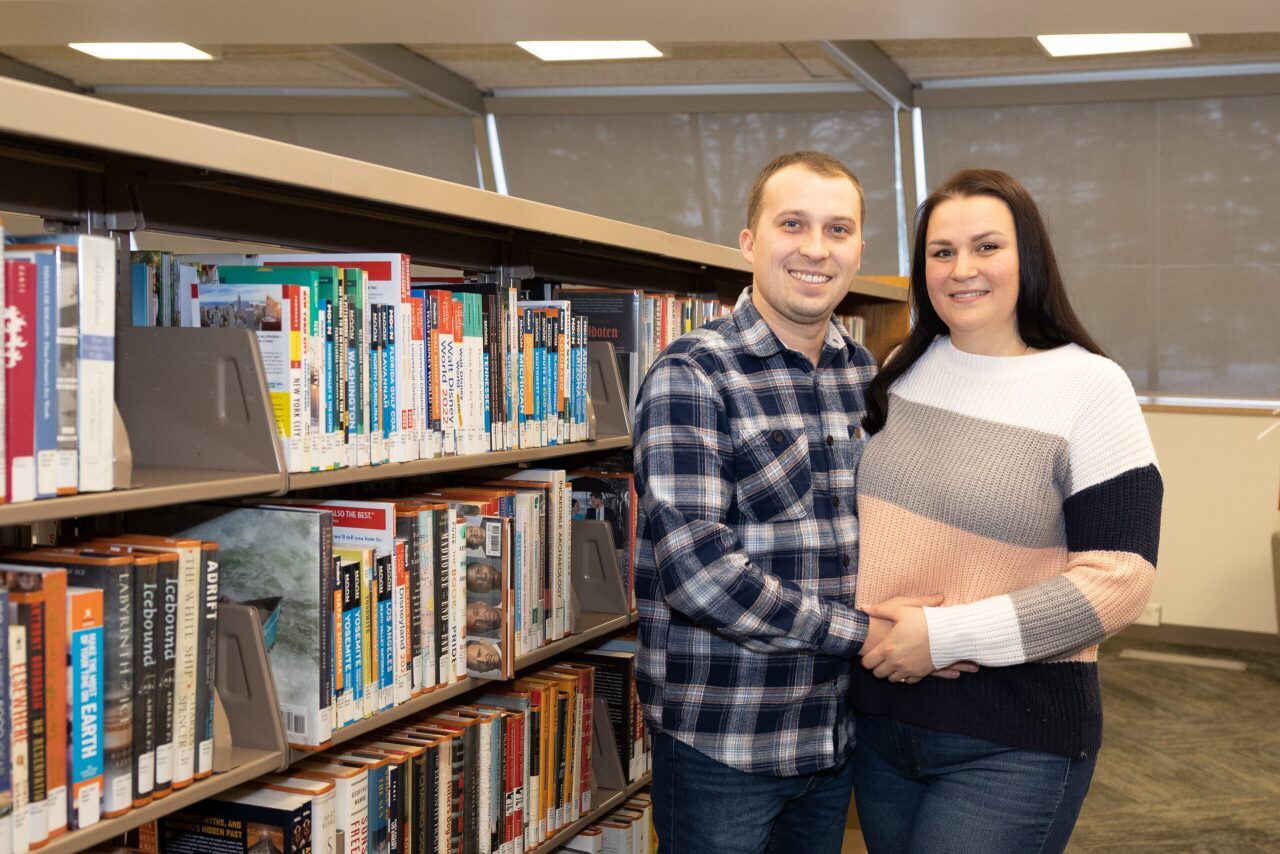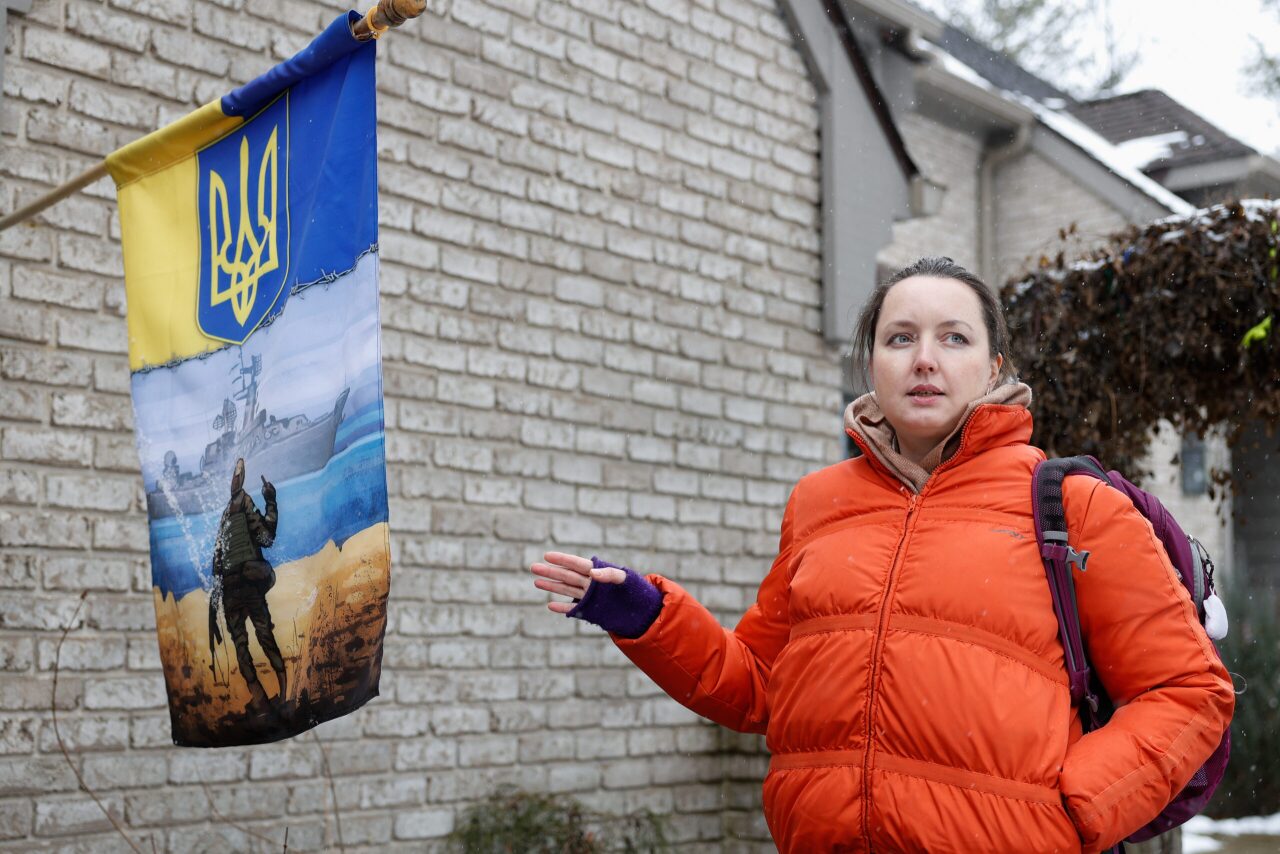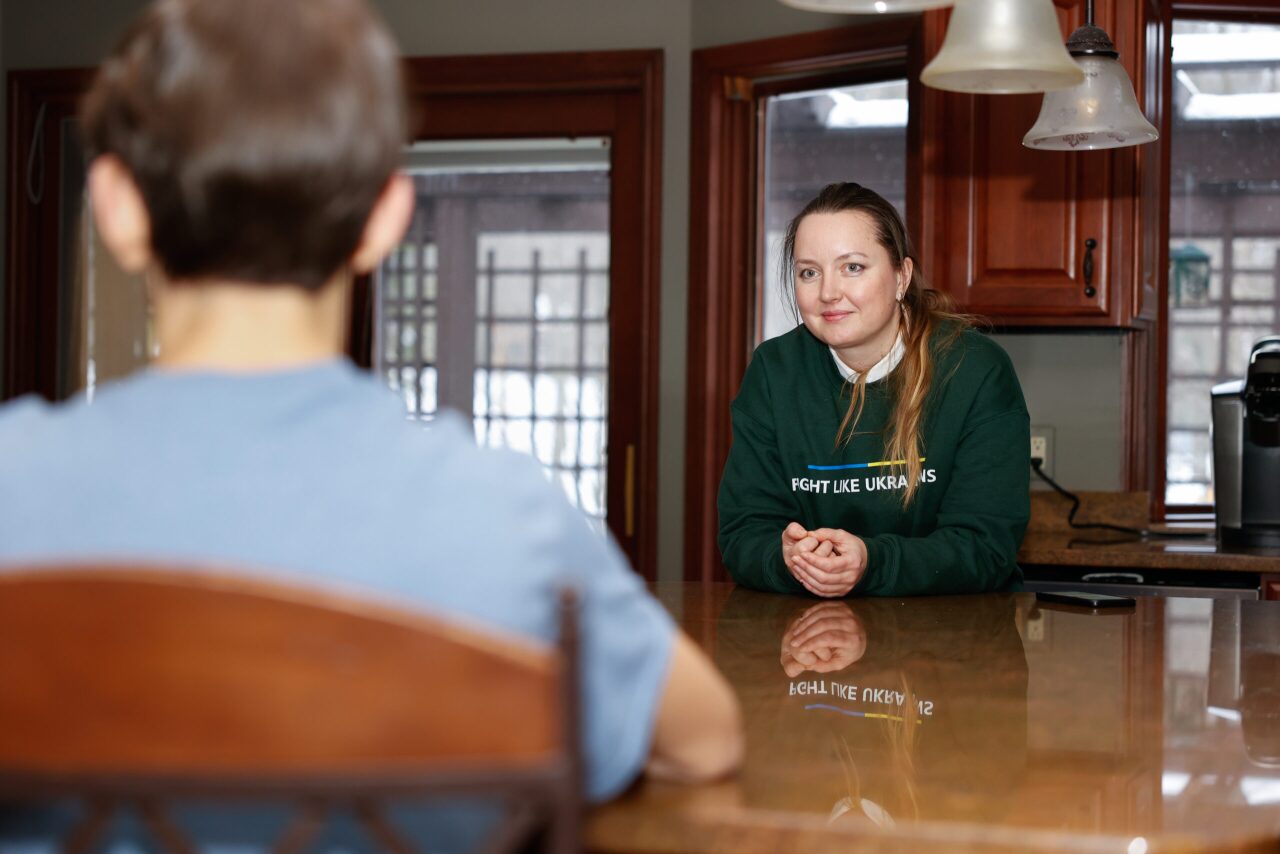The following article was originally published in the Ohio Capital Journal and published on News5Cleveland.com under a content-sharing agreement.
In the mornings, Oksana Donobros walks through the gift shop at the Ukrainian Museum-Archives in Cleveland, checking inventory and boxing up orders that came in overnight. In the evening her sons try to keep up with schoolwork here as well as homework from their classes in Sumy. Oksana is eager to get home. They’ve already got return tickets for March.
Elsewhere in the museum, two Ukrainian students are digging through archives for their bachelor’s theses. They describe a jolt of fear when fireworks go off and hearing sirens that aren’t there.
In nearby Parma, Marta and Taras Chaban are almost giddy describing how well their kids have acclimated to school. They miss home — talking lovingly about the smell of coffee in Lviv — but don’t want to return until they’re certain it’s safe.
At the third-floor offices of U.S. Committee for Refugees and Immigrants, Anna Messerly helps guide new arrivals through applications for support services and work authorization. Messerly left Ukraine in 2014, and many staffers are new arrivals themselves. Ivan Prodanyk and Viktor Ordin both fled violence in Ukraine and found work here helping others in a similar situation.
This is what life looks for more than 4,000 Ukrainians sheltering near Cleveland as the war back home nears its first anniversary. They’re primarily staying in the U.S. under the Uniting for Ukraine or U4U program, which grants shelter and access to certain benefits for those with a domestic sponsor.
In his inauguration address Gov. Mike DeWine insisted Ohio is ready and even eager to welcome Ukrainians into its communities. At the same time, Ohio’s newest U.S. Senator, Republican J.D. Vance, is sending a very different message.
Continuing a campaign trail theme, Vance has expressed deep skepticism of U.S. aid to Ukraine. He was the lead signatory in January for a letter asking the Biden administration to provide “a full crosscutting report” on all expenditures for Ukraine or countries impacted by the war. More recently, Vance has voiced opposition to sending M1 Abrams tanks.
Despite those mixed messages, the people sheltering in the U.S. feel welcome, if not entirely comfortable. They’re grateful for the support, particularly in a community with such deep Ukrainian roots. But it’s still not home. For many, the simplest parts of the day — going to work, getting groceries — feel unfamiliar and complicated, as if they’re constantly working left-handed.
They’re all eager in one way or another for home.
The Ukrainian Museum-Archives

The past year has been an odyssey for Oksana Donobros. She’s from Sumy, in the northeastern region of Ukraine, not far from the border with Russia. It was the site of fierce fighting early in the war and her family had to shelter in place. Once the armies established a “green corridor” for safe passage, she fled to Poland with her sons Andrew and Serhii. Her husband, who is a doctor, stayed behind to serve as a medic.
In Poland, Dobronos was able to connect with a host family in Ireland. “We lived three weeks with that family,” she explained, “and then we moved to another part of Ireland to another family because they had a little small house behind their house.” After three months they returned home to Sumy.
Around the same time, the U.S. started the U4U program, and a distant relative on her husband’s side offered to host them. They left for the U.S. last August.
The initiative allows Ukrainians displaced by war to apply for a status known as “humanitarian parole.” Parolees can only stay for two years and need a sponsor in the U.S. who agrees to support them financially. Parole status doesn’t always include work authorization, but federal officials have offered it to Ukrainians and Afghans who enter as parolees.

That’s how Dobronos wound up running the museum gift shop — ordering souvenirs and pysanky egg kits for the Easter bazaar while trying not to fret about her husband and sons. She has shelter, a job, and a car to get around, but the stress is written on her face and rattles her voice.
She and her sons are planning to return to Ukraine next month.
“I realize that there is dangers, but as well I want to keep my family together with our husband,” she said, explaining her return to Sumy. “He comes back from his work, he comes alone in a dark apartment without electricity, and he even has no one to talk to.”
She worries as well about the strain her kids are going through.
“They go in the morning to this American school, then after they come back, just a little short gap to have some dinner and then we start to do our Ukrainian school,” she described. “This is hard for children and I believe it will be, like, be a little easier for them. Not so safe, but easier physically to go only one school.”
Dobronos’ eldest, Andrew, is in ninth grade and speaks English well, so he’s been able to acclimate pretty easily. But her second grader Serhii doesn’t have the same grasp on the language. Dobronos has to help him through his homework most nights.
Meanwhile, she’s trying to keep up with English classes of her own and all of the “family work” she used to do. She gets upset with herself when, inevitably, there aren’t enough hours in the day. Dobronos described being overwhelmed at a grocery store when a guy offered to let her go ahead of him in line.
“He told me, ‘Oh, you go before me,’” she said. “I was just — I don’t know, I was crying so, ‘Oh, why you do this?’ It was really like all people here really kind and welcoming.”
Sofiia and Halshka

Upstairs at the museum, Sofiia Turko and Halshka Shkrabiuk dig eagerly into a flat file cabinet. They’re only in the U.S. for a couple of weeks doing research for their final projects at Ukrainian Catholic University in Lviv. From the drawers they pull old posters, pamphlets, and scanned newspapers.
“Something like that,” Turko said, holding out a black and white poster of a woman screaming and holding what appears to be lifeless body. “It’s about death,” she added.
Turko is writing about the Ukrainian famine of 1932-33, “which Russia done, yeah?” she added. Shkrabiuk is looking at how the Ukrainian diaspora’s cultural contributions during The Great Depression in the U.S.
They’d begun planning their visit with the university prior to the war, and Shkrabiuk explained the hostilities have only raised the stakes for their work.
“In Ukraine we have we have problems with remembering of our history, and we need now more and more to write about that,” she said.

Unfolding a broadsheet copy of a newspaper, Turko pointed to famine-era headlines saying Russia should be put on trial.
“It’s so interesting for us because we can compare different years, different centuries, and we know that it’s the same history about us and about Russia,” she said.
Even though they’re now thousands of miles from conflict, they don’t feel at ease.
“It’s not safety for us,” Turko said. “It’s dangerous for us because in Ukraine we feel more safe like with our families.”
Shkrabiuk jumped in, “Because we know what is going on, and we are with our family. We know the situation. And now, here, I do not know when it is sirens, missile rapid, I don’t know.”
“Where for example is my sister? My dad? and that’s quite…” she said, running out of words.
Turko and Shkrabiuk had to go to Warsaw to get visas. They thought they might be under attack when fireworks went off nearby. At another point they thought they heard sirens warning of an impending missile attack even though they were in a different country far removed from war. Even now, a loud car driving by puts Shkrabiuk on edge until she reminds herself where she is.
Marta and Taras

In nearby Parma Heights, Marta and Taras Chaban trudge through drifting flurries toward the library. They visit in the evenings twice a week for English classes.
With the help of a translator, they described their last weeks of life in Ukraine. Sirens woke them most nights. They had to roust their children from their beds and rush to the apartment building’s bomb shelter. “Five, six hours, sleeping in the basement,” Taras described. Their son Marko is six, their daughter Yeva is three. By April last year, the accumulated stress convinced them it was time to leave.
“Biden say about new program, and we sit down in the house, and think maybe we need to go to U.S.A because we have two kids,” Taras explained.
In June, the family arrived in the U.S. under the U4U program. Tears welling, Marta described how Marko asked her if the planes at the airport were going to bomb them.
Like Dobronos’ family, their path to Ohio hasn’t followed a straight line. Initially they spent three months in Massachusetts before coming to Parma. The Chaban’s felt welcome in Massachusetts, but being embedded in a Ukrainian community has made them feel at home.
“Especially here was really helpful,” the translator explained, “because basically they moved into empty house, so people brought them everything, and were helping with advices and also material stuff.”
Most importantly, Marko has blossomed.
“Our son have many friends, and six months but he speaks English very well,” Marta beamed. “My mother said ‘Marko, can you learn me English, too? It’s very good.”
They’re currently renting a house that they share with Marta’s parents and younger sister. Marta’s brother is serving in the Ukrainian military, and her younger sister played a big role in convincing their parents to come to the U.S.
It took a while, but the Chabans have work authorization. Taras got a job in IT. He used to work as a supply manager in Ukraine. Marta used to be a lawyer, but she’s been a stay-at-home mom since Marko was born.
Apologetically, they explain bread in the U.S. is nothing compared to what they were used to in Ukraine, but the thing they miss most is coffee in Lviv. “It’s capital of coffee in Ukraine,” Taras insisted.
“You go to the center of the city and smell coffee,” Marta said, struggling for the next word. She turned to the translator then added, “It’s goosebumps.”
The family can stay in the U.S. until June of next year, and they’re not thinking yet about what comes next. They’re definitely not planning to return with two young kids in tow while the war continues. And even once fighting ends, they’re not going to rush back.
“Definitely they will not go back right away,” the translator explained. “They want to know the condition of everything, you know. But on the other case, they’re not going to stay here illegally.”
Oksana and Andrew

After work, Oksana Dobronos makes the 20-minute commute to Brecksville. She and her sons are staying in a sprawling, beautiful home with their sponsor, Michael Dobronos, an attorney who used to serve on Ohio’s Industrial Commission. Oksana misses her old routine of walking to and from work, though. She described how she sometimes walks through a nearby park before heading home from the museum.
Walking up the driveway, she proudly shows off a flag commemorating the defense of Snake Island. A handful of lightly armed border guards refused to surrender to the Russian warship Moskva in the widely publicized incident. Over the radio one of the defenders said, “Russian warship, go f— yourself.”
Ukraine turned it into a postage stamp, Dobronos explained.
Inside, she introduced her son Andrew. He’s a typical high schooler — a bit gangly, as if still growing into his latest spurt, and seemingly ecstatic to have a first period study hall instead of class. He shrugs off the challenge of keeping up with two sets of coursework. It’s not difficult, he said, just time consuming.
Andrew’s favorite subject is biology, and he’s enjoyed psychology and health courses here in the U.S, as well. He likes health, he said, because of the teacher’s sense of humor. The instructor gave them a scenario — a person unconscious with pills nearby — and asked Andew what happened.
“I said, maybe they forgot to take their pills,” Andrew recalled, “And he said, ‘That’s a really kind assumption.’ Then he asked the next girl and she said, ‘Oh, that’s drug overdose,’ and I was like, Oh, right. That’s what it is.”

Andrew isn’t counting down the days to their return, but he is eager to get home. He said the first thing he’ll do is probably visit his grandmother. As for what he misses besides family and friends, “It’s mostly the food,” he said. “Like in Ukraine, we have this specific kind of bacon.” His mother brought up the exact same thing earlier that day.
Still, returning home isn’t without its complications.
“We’re close to the border,” he said, echoing a concern his mother raised. “If some sort of new offensive will launch from the north, it is quite likely they that they will affect us.”
Less immediate, but no less concerning, Andrew is 14 — just a few years from draft eligibility.
“If I need to, I’m not like, really, really against it,” he said at the prospect of fighting. “Also, I don’t really believe it actually will last until I turned 18.”
He could be right. In less than a year, Ukraine has fought Russia to a stalemate and in some regions even pushed their lines back.
On the other hand, the present hostilities are just the latest phase in a conflict that stretches back to the invasion of Crimea in 2014.
Taking an even broader perspective, as Sofiia Turko and Halshka Shkrabiuk are doing in the archives, today’s fighting is only one instant in a decades-long stretch of antagonism. Andrew’s mother is certainly taking the long view.
“Well, he wasn’t worried,” she interjected. “I was worried. So that is why I asked him to think about maybe he wants to enter some European university or college or something.”
Going home
With their return home approaching, Oksana and Andrew are reflecting on how grateful they are for a place where they could shelter in safety. Oksana brings over a professionally bound family album packed with photos from a party their sponsor Michael hosted. She shows one photo with herself and her two sons squeezed in among maybe 20 members of the extended family.
“They were just like our distant relatives,” Andrew explained, “but we just felt like that they support us and they love us.”
In the foyer, Oksana pointed out several old suitcases arranged on a ledge above the door. They’re the sum total, she explained, of what their Michael’s grandparents brought when they immigrated to the country.
“He told us many times that other people helped my grandfather and my grandmother when they came here without anything. Without money, without family — like we have now,” she explained. “He says we ought to help, to you or other families. They feel that they owe us to do something because they got that help when they came here.”
Tomorrow, OCJ will be back with a look at the U.S. Committee for Refugees and Immigrants. The nonprofit works to help new entrants find their footing in the United States. In Cleveland, their staffers — some of whom fled the war themselves — are working to help Ukrainian parolees get housing, employment and support services.








